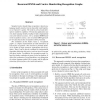Free Online Productivity Tools
i2Speak
i2Symbol
i2OCR
iTex2Img
iWeb2Print
iWeb2Shot
i2Type
iPdf2Split
iPdf2Merge
i2Bopomofo
i2Arabic
i2Style
i2Image
i2PDF
iLatex2Rtf
Sci2ools
ICDAR
2009
IEEE
2009
IEEE
Recurrent HMMs and Cursive Handwriting Recognition Graphs
Standard cursive handwriting recognition is based on a language model, mostly a lexicon of possible word hypotheses or character n-grams. The result is a list of word alternatives ranked by confidence. Present-day applications use very large language models, leading to high computational costs and reduced accuracy. For a standard HMM-based word recognition system, a new recurrent HMM approach for very fast lexicon-free recognition will be presented. The evaluation of this model creates a "recognition graph", a compact representation of result alternatives of lexicon-free recognition. This structure is formally identical to results of single character segmentation and recognition. Thus it can be directly evaluated by interpretation algorithms following this process, and can even be merged with these results. In addition, the recognition graph is a basis for further evaluation in terms of word recognition. It allows fast evaluation of word hypotheses, easy integration of vario...
| Added | 18 Feb 2011 |
| Updated | 18 Feb 2011 |
| Type | Journal |
| Year | 2009 |
| Where | ICDAR |
| Authors | Marc-Peter Schambach |
Comments (0)

